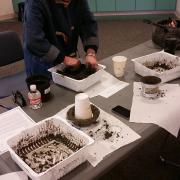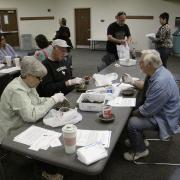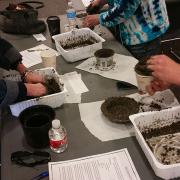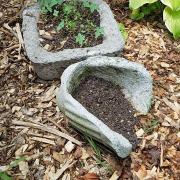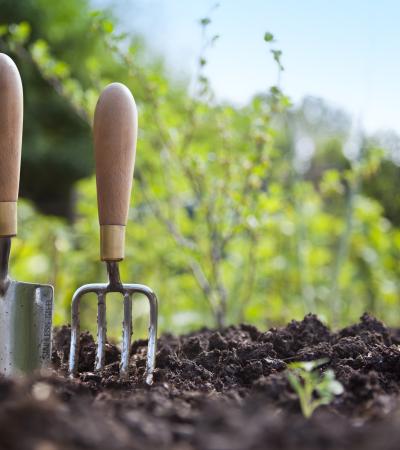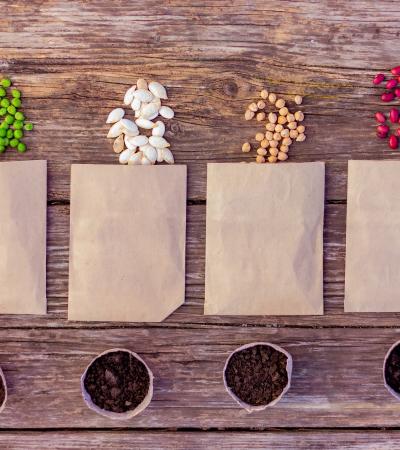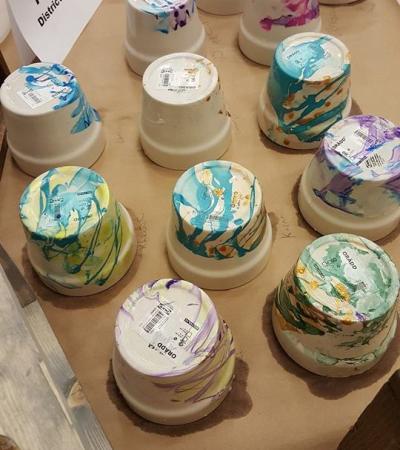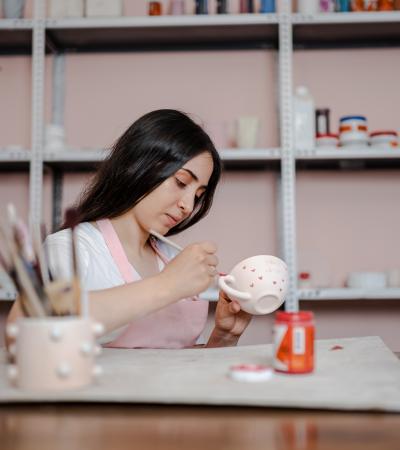Hypertufa is a building substance that has been popular with hobby gardeners since its creation in the 1930s. It is made from a mixture of peat moss, perlite, Portland cement and water. It can be formed and shaped to create pots, planters and statuary for gardens.
In this program, patrons watched a live demonstration of the hypertufa mixing process, then used the mixture to create their own pots for their home gardens. This program is designed for adults only.
Advanced Planning
I am a huge proponent of hands-on adult programs because I believe adults do not get enough opportunities to participate in these types of activities. My goal for any adult program is to provide them with an experience they could not readily receive anywhere else in the community.
Before hosting this program, make sure to do hypertufa at least once by yourself. Know the hypertufa process and the proper precautions to take to ensure ingredients are mixed safely and appropriately. Don’t wing it.
Here is a great video from Lowe's that I used to help me plan and visualize the program:
Give yourself at least a month to plan and gather supplies. This program is best done outside but can also be done inside in a well-ventilated area, so make sure your facility can accommodate this type of program.
Require registration! The maximum number of patrons I’ve found that I could manage with help from a staff person was 30, but that was pushing it. Between 15 and 20 is a much more comfortable, manageable number. The third time I did this program, I actually did it in one-hour sessions so I could accommodate a higher total of patrons while keeping the experience meaningful and manageable.
Marketing
I have done this program three times. I think it is best suited to areas where people garden outdoors. The branch where I did this program is situated in a community of established families and retirees — in other words, people who frequently garden and have time to do additional projects. I always do this program in the spring because that is when everyone in southwest Missouri starts planting seeds and planning their gardens.
The program was promoted through our quarterly publication/program listing called Bookends. Our program listings are also released to local media (newspaper, television, radio), but I am not sure if this event was promoted in any of those outlets. I did not do any specialized promotion (fliers, signs, etc.) for this particular event.
Also, people don’t typically know what hypertufa is, so be sure to give a little more information with any marketing that you do. It’s a silly word that will draw the patron in to reading your description, so be sure to include a good description! The description should always explain what hypertufa is and exactly what patrons can expect out of the program.
Budgeting
If you plan well, supplies for this program cost less than $50. Peat moss, perlite and Portland cement are available at Lowe’s or Home Depot in the gardening section. A 47-pound bag of Portland cement costs around $6. Perlite is around $4.77 per bag (I used two bags). Peat moss comes in large cubes for around $12 (I used one large cube).
Other supplies can be scrounged up pretty easily. I used a large plastic storage tub and a mason jar for the mixing demo. For patrons to form their creations, we used yogurt containers, cups, milk jugs, plastic pots (like you buy plants in at the nursery), pan lids, etc. About a month before the program I asked friends, family and coworkers to save these items, giving me more than enough to work with.
Since I did a live demonstration of the mixing process, I only needed one mask and one pair of safety goggles for myself. I also provided vinyl gloves for everyone as hypertufa can be very drying to the hands.
Day-of-event Activity
Give yourself plenty of time to set up on the day of the event. I stationed myself at the front of the room at a table with all of the necessary hypertufa ingredients, water, goggles, gloves, an apron, etc. I had another table with a box of gloves and supplies for patrons to choose from to make their creations.
I arranged tables in a horseshoe shape facing the demo table so everyone could see what I was doing and I could easily stand in one spot between the tables and my demo table to supervise, retrieve supplies, etc. Our tables are heavy-duty plastic and easy to clean, but you could put down plastic sheets on the tables for easier clean-up.
I placed the instructional handout at each seat. (View handout under Attachments at right.) I also had gardening books from our collections on display, as well as photocopies of hypertufa articles from various garden magazines for patrons to take home .
I had one staff member helping me with the demo and answering patron questions.
Program Execution
The most important thing to remember when executing your program: it is safer and more efficient to demo the mixing process for patrons. I would not suggest letting patrons do the mixing. They still get the idea of how to go home and do it themselves, but you don’t have to deal with the mess or the safety concern of patrons breathing in cement dust.
As patrons entered the room I had them sit at the horseshoe tables and encouraged them to browse the instructional handout. I introduced myself, gave a description of the history of hypertufa, outlined the process of building with hypertufa, then explained that I would demo the mixing process.
After I demonstrated the mixing process, patrons came to the front of the room to retrieve their own gloves and choose the forms they wanted to use for their creations out of the reused yogurt containers, lids, etc. Then I had my assistant help divvy out the hypertufa — with its mud-like consistency — to each table.
At the end of the program, patrons were allowed to take their creations home. A crucial part of the hypertufa process is allowing the material to cure. Hypertufa should be lightly wrapped in plastic and allowed to sit in the mold for 24 hours. After 24 hours, the mold can be removed, but the pot still needs to sit lightly covered in plastic in a dry place for about three weeks. I provided plastic bags for patrons to put their pots in and also curing reminders that they could put on their fridge to remind them how to take care of their pot after they left the program. (View handout under Attachments at right.)
Patrons were brimming with questions, and the format of the program allowed them to socialize about their own gardens and projects while they worked with the hypertufa. I believe the hands-on component was key to this program’s success.
Feedback from the program was phenomenal. Patrons loved getting to shape and form their own hypertufa pots and said it was one of the most unique experiences they had in a long time. I repeatedly heard, “Who knew we could do this at the library?!” (Music to my ears!) Many patrons returned to me several weeks after the program to tell me how their hypertufa looked in their garden or how they had gone on to make their own creations. Many patrons who missed the program contacted me asking where to get materials.
This program spawned the creation of several more interactive, messy types of programs for adults at my branch of the library and garnered a following of devoted patrons who would attend my monthly hands-on programming.
Advice
With great risk comes great reward. I realize this program may seem daunting or laborious, but the payoff of providing this type of patron experience is so worth it. This program is interactive, it encourages socialization, and it is a great way to demonstrate the value of adult programming to your community.
Many of the program participants came back to me at a later date to tell me about their own creations they had gone on to make after the program was over. Plus, the product of the program is its own library advocate! Everyone that visits that patron’s home and sees their hypertufa may ask “Where did you get that?” and they will say “I made it at the library!”
If you want to do this or other hands-on programs for adults, reach out to me. I'd love to offer my advice and encouragement!

